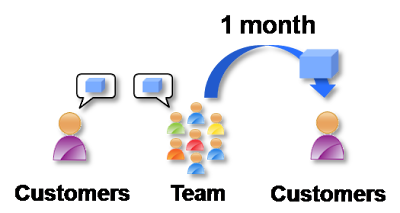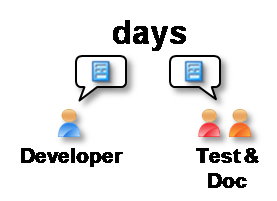In the previous post we saw two ways that traditional development is like the game of telephone. First, communication suffers from translation errors at each stage of the development cycle. Second, the frequent attempts to detect, prevent, and recover from translation errors require people to remember details about work they did weeks or months in the past. This is unfortunate because people are much better at remembering something they did within the past couple of days than they are at remembering something they did weeks or months ago.
One of the advantages of Agile development is that it leverages human strengths and minimizes the need for humans to do things that humans do poorly. In the case of communicating important concepts throughout the development cycle, Agile relies on four tools: user stories, one piece flow, conversations, and reduced documentation.
A user story is a simple statement in plain English of a value proposition that the end user of the software is interested in. For instance, "As a user, I want to purchase an item I am looking at with a single click." The main value of user stories for communication is that they are used by everybody involved in the development of that story, from user to tester. While the story may be translated into a design document or test cases, the original intent of the user is always available as a double-check via the user stories.
An important part of increasing communication effectiveness is a concept called "one piece flow" which comes from Lean. The idea of one piece flow is that each aspect of developing a user story happens in rapid succession, and that each team member focuses on a single user story at a time. The result of one piece flow is that the time between when the team first commits to doing a user story and they can ship it fully developed, tested, and documented is very short. The timeframe is generally on the order of a week at most and usually days.
Because user stories go from start to finish in such a short period of time, the bulk of the communication that occurs on behalf of a user story is done via conversations. Of course, Agile teams do document their work, but it is for the purpose of creating an audit trail, not for the purpose of short-term communication between team members. Conversations are a much better way to communicate technical concepts than documentation.

Conversations between Agile teams and their customers
From the perspective of a customer, the time between when they provide detailed information about a feature and when they can see a demo of the result is often as short as a month. Also, the scope of functionality is going to be much less. The reduction in timeframe and scope means that it is much more likely that a customer will remember exactly why they wanted something and that they will be much more able to provide useful feedback on the result.
That doesn't mean that all customers have to be involved every month, only that there is an opportunity to go full circle with customers over a much shorter period of time than with traditional development. Consequently, miscommunication can be caught earlier and corrected faster.

Conversations in an Agile team
From the perspective of individual team members, interaction is now focused on a specific user story at any given time and the timeframe of its development is on the order of days rather than months. Work can be initiated, rapidly completed, and then confidently considered done instead of having an ever growing list of work in progress. With Agile development, the amount of work in progress is very small and is constantly changing. There is much less of a need to rely on piles of documentation or on the long term memory of oneself or others.
Are you an Agile Do It Yourselfer? Check out the web-only book
No comments:
Post a Comment